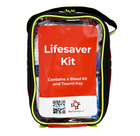Amputations
Unlock This Video Now for FREE
This video is normally available to paying customers.
You may unlock this video for FREE. Enter your email address for instant access AND to receive ongoing updates and special discounts related to this topic.
First Aid for Amputations: Key Steps and Precautions
In some emergency situations, you may have to deal with an amputation caused by car accidents, machinery accidents, or even explosions. Although this can be a difficult and gruesome situation, proper first aid can help save a life.
Understanding Blood Loss in Amputations
Amputations may not always result in significant blood loss, as arteries can retract and muscles can clamp down on them. However, in cases where a major arterial bleed occurs, blood may spurt out, requiring immediate attention.
Using Tourniquets for Amputations
Direct pressure on the wound may not be sufficient for amputations. Instead, a tourniquet should be used. There are two main options: the Tourni-Key or commercial tourniquets. If these are unavailable, an improvised tourniquet can be made.
Placement of Tourniquets
- Place the tourniquet above the wound but avoid placing it over a joint.
- Tighten the tourniquet until blood flow stops. If bleeding continues, tighten it further.
- If bleeding persists, apply a second tourniquet above the first.
It is essential to act quickly, especially if the femoral artery is cut, as the person may only have a few minutes to be saved.
Stabilsing the Patient
Once bleeding is controlled, stabilise the patient and check for other injuries. In cases of amputation, swift action is crucial to saving the person's life.







.png)